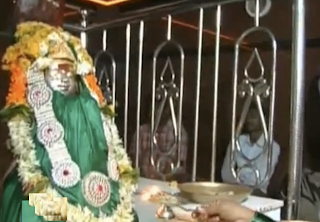Vijayanagara Dynasty was established in 1336 by Hakka & Bukka under the able guidance of Vidyaranya Guru. Vijayanagara is referred as the Kingdom of Bisnaga by the Portuguese. It lasted until 1646 although its power declined after a major military defeat in 1565 by the Deccan sultanates. The following temple story has to do everything with Vijayanagara Dynasty’s abrupt end. Bhuvaneshwari is the family deity of Vijayanagar Dynasty Kings. Rama Raya the last ruler ignored the family deity’s warning and allied with Deccan Sultanates. Vijayanagara Dynasty was built to protect Karnataka from Islamic invasion. Hakka & Bukka brother duo reverted to Hinduism after their brief conversion to Islam. Goddess warned Rama Raya several times on the repercussions of the alliance with the Sultanates and the King paid no heed. She even showed up in his dreams and said she will leave if he does not drop the alliance with the invaders, Rama Raya still did not care. Dejected by the mistreat, goddess leaves the kingdom. When she left, all the fortunes went with her. Rama Raya was killed by the Sultanates in he battle of Talikot and vijayanagar doomed forever.
After leaving the kingdom, goddess swam through Thungabhadra and Krishna rivers. Finally she came to Bheema river and stayed underneath the river. She penanced underneath the waters for several years. Jamanna was a shepherd and was grazing cattle when he heard voices resonating underneath the water. The shepherd was a stanch Devi devotee and started praying on the banks. The goddess pleased by his devotion appeared to him and narrated the story. He regularly prayed to the Devi. He went to the village and informed this to the village chieftains. Many believed but there were skeptics who doubted the story. So they all gathered at the river banks. A huge snake showed up to them first followed by a glass pillar. A voice from the pillar resonated asking the villagers to take her with them. Everyone was very happy and delighted to take the goddess (now in the pillar form) with them to the village. But no one was ready to bring it to the shore. The shepherd took the responsibility and brought it to the shore. They took the glass pillar with them all of a sudden a snake accompanied along. The villagers were very scared. The snake vanished but the pillar turned to a black stone pillar. The chieftains welcomed and women offered vermilion, turmeric, flowers and burnt the incense sticks and prayed to the pillar. Pillar was first kept at the Jamanna's door steps. She appeared in Channamma Gowd’s dreams and expressed her wish to stay in their house and vanished. Chennamma was the mother of the village chieftain. Next day, she narrated her dreams to her son and the son was more than happy to fulfill goddess desire. The pillar was installed as per goddess wish. From then on the village and the village chieftains worshiped & they prospered.
The villagers brought the pillar and built a temple around it. The pillar brought a lot of fortune to the people hence she was named Bhagyavanthy (Fortune Giver). She proved to be Kamadenu and Kalparuksha to the villagers. So, in short she is the family deity of Vijayanagar Kings who flourished when they worshipped her and perished when ignored her. Today the temple is visited by many from all over the country and outside country. This is a place full of miracles and all your sincere prayers are answered. Miracles happen when you believe!















 Tirthankara Parshvanatha was a prince in the kingdom of Kashi. He was known as prince Parshva then. Once he went to see an ascetic who was performing some penance by lighting the logs of wood. On the outskirts of the city this ascetic, whose name was Kamath, was performing the ritual of penance. Parshva had divine vision and only he could see that there were two snakes (male and femalHe asked Kamath to remove that log but Kamath could not see anything and accused Parshva of trying to break the penance. Parshva was the only person there who knew what was happening.When his requests were rejected, Parshva ordered one of his servants to disturb the fire and remove the log in question. Servant did as he was told and everybody saw that there indeed were two snakes in the log. The snakes unfortunately did not survive and died. But before their death Parshva recited Namaskara Mantra and the snakes died in peace.
Tirthankara Parshvanatha was a prince in the kingdom of Kashi. He was known as prince Parshva then. Once he went to see an ascetic who was performing some penance by lighting the logs of wood. On the outskirts of the city this ascetic, whose name was Kamath, was performing the ritual of penance. Parshva had divine vision and only he could see that there were two snakes (male and femalHe asked Kamath to remove that log but Kamath could not see anything and accused Parshva of trying to break the penance. Parshva was the only person there who knew what was happening.When his requests were rejected, Parshva ordered one of his servants to disturb the fire and remove the log in question. Servant did as he was told and everybody saw that there indeed were two snakes in the log. The snakes unfortunately did not survive and died. But before their death Parshva recited Namaskara Mantra and the snakes died in peace.